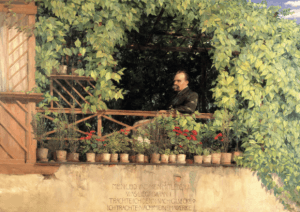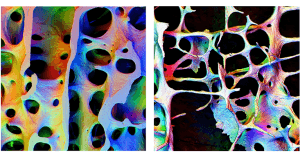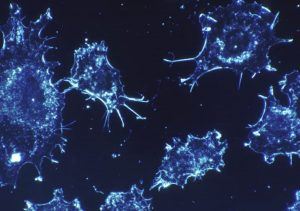Jonathan Rée in Prospect:
 “I am not a man, I am dynamite!” Friedrich Nietzsche is famous for this kind of bombast, but most of his works are unassuming in tone, and his sentences are always plain, direct and clear as a bell. Take for instance the celebrated assault on “theorists” in his first book, The Birth of Tragedy, published in 1872. Theorists, Nietzsche says, know everything there is to know about “world literature”—they can “name its periods and styles as Adam did the beasts.” But instead of “plunging into the icy torrent of existence” they merely content themselves with “running nervously up and down the river bank.”
“I am not a man, I am dynamite!” Friedrich Nietzsche is famous for this kind of bombast, but most of his works are unassuming in tone, and his sentences are always plain, direct and clear as a bell. Take for instance the celebrated assault on “theorists” in his first book, The Birth of Tragedy, published in 1872. Theorists, Nietzsche says, know everything there is to know about “world literature”—they can “name its periods and styles as Adam did the beasts.” But instead of “plunging into the icy torrent of existence” they merely content themselves with “running nervously up and down the river bank.”
Read this word by word and the meaning seems straightforward enough. But it looks rather different when you zoom out to take in the book as a whole. Nietzsche begins The Birth of Tragedy by postulating an eternal conflict between two artistic principles: Dionysiac fury versus Apollonian cool. He then denounces philosophical reason as a sworn enemy to “healthy, natural creativity,” and concludes by saying that salvation lies in German music, beginning with Bach and Beethoven and culminating in Richard Wagner.
You don’t have to be a philosophical genius to notice that something strange is going on. Nietzsche’s grand theory of world culture can hardly be exempted from his own strictures on know-it-all theorists who deliver commentaries from the safety of the river bank.
But that, it seems to me, is where the fascination of Nietzsche lies.
More here.

 DeVore had hanging in his office an 1838 quote from Darwin’s notebook: “Origin of man now proved … He who understands baboon would do more towards metaphysics than Locke.” It’s an aphorism that calls to mind one of my favorite characterizations of anthropology—philosophizing with data—and serves as a perfect introduction to the latest work of Richard Wrangham, who has come up with some of the boldest and best new ideas about human evolution.
DeVore had hanging in his office an 1838 quote from Darwin’s notebook: “Origin of man now proved … He who understands baboon would do more towards metaphysics than Locke.” It’s an aphorism that calls to mind one of my favorite characterizations of anthropology—philosophizing with data—and serves as a perfect introduction to the latest work of Richard Wrangham, who has come up with some of the boldest and best new ideas about human evolution. String theory was originally proposed as a relatively modest attempt to explain some features of strongly-interacting particles, but before too long developed into an ambitious attempt to unite all the forces of nature into a single theory. The great thing about physics is that your theories don’t always go where you want them to, and string theory has had some twists and turns along the way. One major challenge facing the theory is the fact that there are many different ways to connect the deep principles of the theory to the specifics of a four-dimensional world; all of these may actually exist out there in the world, in the form of a cosmological multiverse. Brian Greene is an accomplished string theorist as well as one of the world’s most successful popularizers and advocates for science. We talk about string theory, its cosmological puzzles and promises, and what the future might hold.
String theory was originally proposed as a relatively modest attempt to explain some features of strongly-interacting particles, but before too long developed into an ambitious attempt to unite all the forces of nature into a single theory. The great thing about physics is that your theories don’t always go where you want them to, and string theory has had some twists and turns along the way. One major challenge facing the theory is the fact that there are many different ways to connect the deep principles of the theory to the specifics of a four-dimensional world; all of these may actually exist out there in the world, in the form of a cosmological multiverse. Brian Greene is an accomplished string theorist as well as one of the world’s most successful popularizers and advocates for science. We talk about string theory, its cosmological puzzles and promises, and what the future might hold. NOW THAT SHE IS NO LONGER
NOW THAT SHE IS NO LONGER  Neanderthals disappeared from Europe roughly 40,000 years ago, and scientists are still trying to figure out why. Did disease, climate change or competition with modern humans — or maybe a combination of all three — do them in? In a recent
Neanderthals disappeared from Europe roughly 40,000 years ago, and scientists are still trying to figure out why. Did disease, climate change or competition with modern humans — or maybe a combination of all three — do them in? In a recent  Simplicity, simplicity, simplicity!” Henry David Thoreau exhorted in his 1854 memoir Walden, in which he extolled the virtues of a “Spartan-like” life. Saint Thomas Aquinas preached that simplicity brings one closer to God. Isaac Newton believed it leads to truth. The process of simplification, we’re told, can illuminate beauty, strip away needless clutter and stress, and help us focus on what really matters. It can also be a sign of aging. Youthful health and vigor depend, in many ways, on complexity. Bones get strength from elaborate scaffolds of connective tissue. Mental acuity arises from interconnected webs of neurons. Even seemingly simple bodily functions like heartbeat rely on interacting networks of metabolic controls, signaling pathways, genetic switches, and circadian rhythms. As our bodies age, these anatomic structures and physiologic processes lose complexity, making them less resilient and ultimately leading to frailty and disease.
Simplicity, simplicity, simplicity!” Henry David Thoreau exhorted in his 1854 memoir Walden, in which he extolled the virtues of a “Spartan-like” life. Saint Thomas Aquinas preached that simplicity brings one closer to God. Isaac Newton believed it leads to truth. The process of simplification, we’re told, can illuminate beauty, strip away needless clutter and stress, and help us focus on what really matters. It can also be a sign of aging. Youthful health and vigor depend, in many ways, on complexity. Bones get strength from elaborate scaffolds of connective tissue. Mental acuity arises from interconnected webs of neurons. Even seemingly simple bodily functions like heartbeat rely on interacting networks of metabolic controls, signaling pathways, genetic switches, and circadian rhythms. As our bodies age, these anatomic structures and physiologic processes lose complexity, making them less resilient and ultimately leading to frailty and disease. Today, cars with semi-autonomous features are already on the road. Automatic parallel parking has been commercially available since 2003. Cadillac allows drivers to go hands-free on pre-approved routes. Some B.M.W. S.U.V.s can be equipped with, for an additional seventeen-hundred dollars, a system that takes over during “monotonous traffic situations”—more colloquially known as traffic jams. But a mass-produced driverless car remains elusive. In 2013, the U.S. Department of Transportation’s National Highway Traffic Safety Administration published a sliding scale that ranked cars on their level of autonomy. The vast majority of vehicles are still at level zero. A car at level four would be highly autonomous in basic situations, like highways, but would need a human operator. Cars at level five would drive as well as or better than humans, smoothly adapting to rapid changes in their environments, like swerving cars or stray pedestrians. This would require the vehicles to make value judgments, including in versions of a classic philosophy thought experiment called the trolley problem: if a car detects a sudden obstacle—say, a jackknifed truck—should it hit the truck and kill its own driver, or should it swerve onto a crowded sidewalk and kill pedestrians? A human driver might react randomly (if she has time to react at all), but the response of an autonomous vehicle would have to be programmed ahead of time. What should we tell the car to do?
Today, cars with semi-autonomous features are already on the road. Automatic parallel parking has been commercially available since 2003. Cadillac allows drivers to go hands-free on pre-approved routes. Some B.M.W. S.U.V.s can be equipped with, for an additional seventeen-hundred dollars, a system that takes over during “monotonous traffic situations”—more colloquially known as traffic jams. But a mass-produced driverless car remains elusive. In 2013, the U.S. Department of Transportation’s National Highway Traffic Safety Administration published a sliding scale that ranked cars on their level of autonomy. The vast majority of vehicles are still at level zero. A car at level four would be highly autonomous in basic situations, like highways, but would need a human operator. Cars at level five would drive as well as or better than humans, smoothly adapting to rapid changes in their environments, like swerving cars or stray pedestrians. This would require the vehicles to make value judgments, including in versions of a classic philosophy thought experiment called the trolley problem: if a car detects a sudden obstacle—say, a jackknifed truck—should it hit the truck and kill its own driver, or should it swerve onto a crowded sidewalk and kill pedestrians? A human driver might react randomly (if she has time to react at all), but the response of an autonomous vehicle would have to be programmed ahead of time. What should we tell the car to do? Last week, as world leaders and business elites arrived in Davos for the
Last week, as world leaders and business elites arrived in Davos for the  A new report from the
A new report from the  In 1966, Robert “Bob” Taylor, an employee at the U.S. government’s Advanced Research Projects Agency, had an insight that led to the creation of the internet: “[Bob Taylor’s] most enduring legacy, however, was … a leap of intuition that tied together everything else he had done. This was the ARPANET, the precursor of today’s Internet.
In 1966, Robert “Bob” Taylor, an employee at the U.S. government’s Advanced Research Projects Agency, had an insight that led to the creation of the internet: “[Bob Taylor’s] most enduring legacy, however, was … a leap of intuition that tied together everything else he had done. This was the ARPANET, the precursor of today’s Internet. Donald Trump has been hot for Venezuela for some time now. In the summer of 2017, Trump, citing George H.W. Bush’s 1989–90 invasion of Panama as a positive precedent, repeatedly
Donald Trump has been hot for Venezuela for some time now. In the summer of 2017, Trump, citing George H.W. Bush’s 1989–90 invasion of Panama as a positive precedent, repeatedly  Political veterans such as Pelosi and Israel think that the cornerstones of the emerging left platform—housing as a human right, criminal justice reform, Medicare for all, tuition-free public colleges and trade schools, a federal jobs guarantee, abolition of U.S. Immigration and Customs Enforcement and for-profit prisons, campaign finance reform, and a Green New Deal—might perform well in urban centers but not so much elsewhere. Appalachia has become symbolic of the forces that gave us Trump. After all, his pandering to white racial anxiety did find purchase here. His fantasies to make America great again center on our dying coal industry. And the region’s conservative voters, who have been profiled endlessly, have been a reliable stand-in for all Trump voters, absorbing the outrage of progressive readers. But what Pelosi and Israel see as common sense and pragmatism can also be interpreted as tired oversimplifications and a failure of imagination.
Political veterans such as Pelosi and Israel think that the cornerstones of the emerging left platform—housing as a human right, criminal justice reform, Medicare for all, tuition-free public colleges and trade schools, a federal jobs guarantee, abolition of U.S. Immigration and Customs Enforcement and for-profit prisons, campaign finance reform, and a Green New Deal—might perform well in urban centers but not so much elsewhere. Appalachia has become symbolic of the forces that gave us Trump. After all, his pandering to white racial anxiety did find purchase here. His fantasies to make America great again center on our dying coal industry. And the region’s conservative voters, who have been profiled endlessly, have been a reliable stand-in for all Trump voters, absorbing the outrage of progressive readers. But what Pelosi and Israel see as common sense and pragmatism can also be interpreted as tired oversimplifications and a failure of imagination. The potentially game-changing anti-cancer drug is based on SoAP technology, which belongs to the phage display group of technologies. It involves the introduction of DNA coding for a protein, such as an antibody, into a bacteriophage – a virus that infects bacteria. That protein is then displayed on the surface of the phage. Researchers can use these protein-displaying phages to screen for interactions with other proteins, DNA sequences and small molecules.
The potentially game-changing anti-cancer drug is based on SoAP technology, which belongs to the phage display group of technologies. It involves the introduction of DNA coding for a protein, such as an antibody, into a bacteriophage – a virus that infects bacteria. That protein is then displayed on the surface of the phage. Researchers can use these protein-displaying phages to screen for interactions with other proteins, DNA sequences and small molecules. With support from
With support from